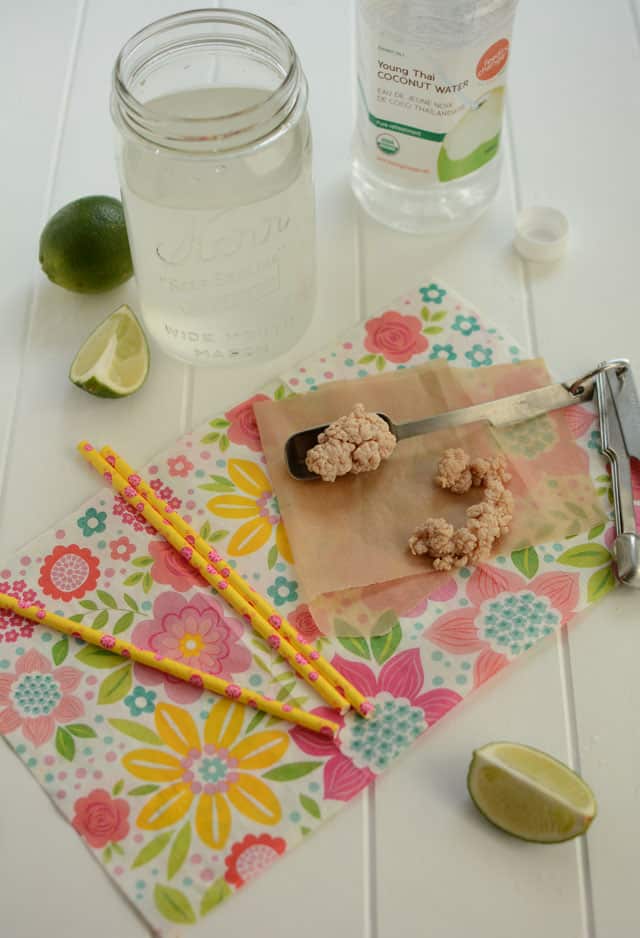Would you love to quench your thirst and replace electrolytes without ingesting
sucrose syrup,
glucose-fructose syrup,
citric acid,
natural and artificial flavors,
salt,
sodium citrate,
monopotassium phosphate,
ester gum,
sucrose acetate isobutyrate and
yellow dye number 5?
Are you on a remote tropical island and in need of an intravenous hydration fluid?
Or, maybe it’s your day at the spa and you would enjoy indulging in a Strawberry Piña Colada Smoothie that not only tastes delicious but is good for your gut.
Perhaps, you are flat on your back after a CrossFit workout and need something to revive you.
Then learn all you need to learn about coconut water and try my two-ingredient recipe for fermented coconut water.
- What is Fermented Coconut Water?
- Purchasing or Making Your Own Coconut Water
- Cultures for Making Fermented Coconut Water
- Sources for Milk and Water Kefir Grains
- A Look at Some Fermenting Coconut Water
- Recipe for Fermented Coconut Water
- 12 Ways to Enjoy Fermented Coconut Water
- Plain Iced Fermented Coconut Water
- DIY Electrolyte Drink
- Cinnamon Coconut Kefir Water
- Fermented Coconut Water Lemonade
- Wellness Shot – Turmeric Tonic with Coconut Water, Ginger, and Honey
- Coconut Mojito
- Gin & (Fermented) Coconut Water
- Post-Workout Chocolate Coconut Kefir Smoothie
- Strawberry Coconut Water Smoothie
- Morning Strawberry Piña Colada Smoothie
- Coconut Kefir Piña Colada Smoothie
- Green Kefir Smoothie
- BONUS TIP for Car Travelers: Fermenting on the Road
Discover not only the benefits of the current coconut water craze but also the bonus benefits behind fermented coconut water.
Truth be told, I do not like coconut water. It is far too sweet and “flat” for my taste buds.
And, I did not like my first few sips of fermented coconut water. Too coconutty!
But, it grew on me and soon became my go-to drink for hydration and energy.
And I love it when traveling. Fermenting on the go!
What is Fermented Coconut Water?
Let’s first start with what coconut water is and then go on to fermented coconut water.
Coconut water is the juice present inside the interior cavity of young green coconuts. This water is one of nature’s most refreshing drinks, consumed worldwide for its health properties.
Hawaiians refer to coconut water as “Noelani,” (no-way lah-nee) which means ‘mist from the heavens.’ As you sip some coconut water, think Heavenly Mist. So soothing.
Coconut water is not to be confused with coconut milk which comes from the flesh of mature, brown coconuts.
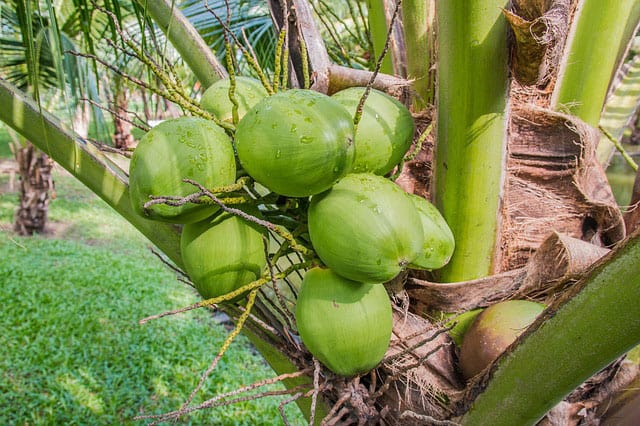
To collect coconut water, green, immature coconuts are gathered from the coconut tree – native to coastal regions of tropical Southeast Asia – when they reach about 5 months of age.
Coconuts younger than 5 months are bitter. Older (10-12 months), mature coconuts contain less water and are instead used for copra, the dried meat from which coconut milk and coconut oil are produced. To make coconut milk the grated meat of mature coconuts is mixed with water and then run through a juicer.
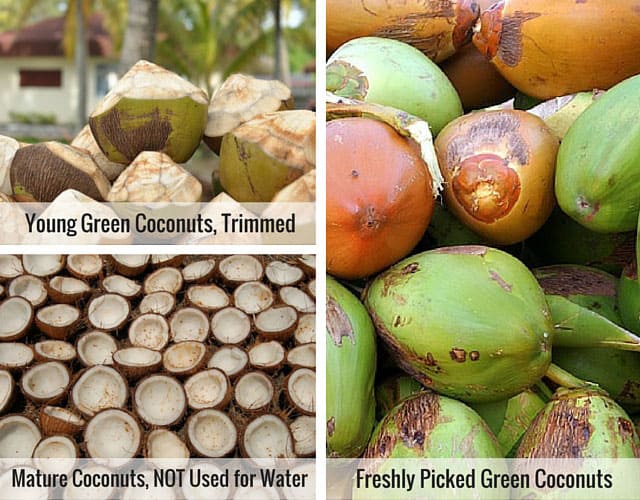
Young, green coconuts contain sweet, flavorful water and are often sold in the tropics by native street vendors with a hole punched into them for a straw.
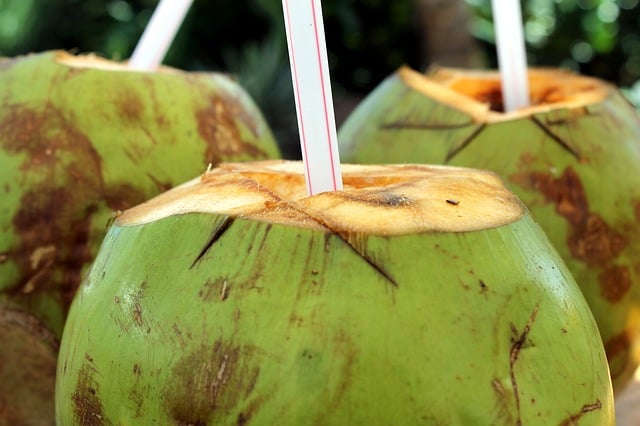
A coconut tree may yield hundreds of flavorful coconuts each season with each coconut containing anywhere from 1 to 2 cups of water. Liquid gold from paradise.
Just imagine yourself on a sunny beach as you drink coconut water. Visual therapy… Heavenly Mist…

Now, on to fermented coconut water.
Fermented Coconut Water
Fermented coconut water is the water from green coconuts that have been fermented using a culture to inoculate the water with various yeasts and beneficial bacteria. It is made in a process similar to other fermented drinks such as Kombucha and kefir.
For example, making Kombucha, a popular health drink is the art of fermenting tea. Sweetened tea is mixed with a culture (Kombucha from a previous batch of the fermented tea) and a SCOBY (a symbiotic culture of bacteria and yeast that grows in the fermenting tea) and fermented for a week to produce an effervescent drink said to help the digestive system and detoxify the body.
Or, making milk kefir, a popular fermented milk, is the art of fermenting (or culturing) milk. Milk kefir grains are added to milk and left to culture for 8 to 24 hours in a warm place. During this time, the bacteria present in the milk and kefir grains go to work for us, growing and multiplying, to turn the milk into a creamy drink with a soured tang.
More about these fermented drinks and other delicious fermented foods in my post:
Fermented Foods ULTIMATE Guide: How to Buy or Make, Ways to Eat & Wonderful Benefits
To make fermented coconut water, the sweet water is mixed with a culture (milk kefir grains, water kefir grains, whey from yogurt, or a powdered starter) and left to ferment for 18 to 48 hours in a warm place. During this time, the bacteria in the culture eat the sugars in the water, grow beneficial probiotics, and create a bubbly, tangy drink with far less sweetness than the original coconut water and many more benefits, mainly probiotics. Fermented coconut water is teeming with beneficial microbes.
A dry champagne spritzer!
Nature’s Gatorade!
Donna Gates’ Body Ecology website is where I was first introduced to fermented coconut water:
“Although the liquid of the young coconut has an abundance of minerals, Donna was concerned that it would be too sweet. Drinking it would make the body too acidic and encourage the growth of pathogens and cancers. The idea to add Body Ecology’s kefir starter to this liquid and “culture it” kept popping into her mind. She knew it would be a perfect medium for the growth of beneficial microflora.”
My recipe at the end of the post explains this simple two-ingredient process.
But for now,
the benefits of coconut water.
15 Health Benefits of Fermented Coconut Water
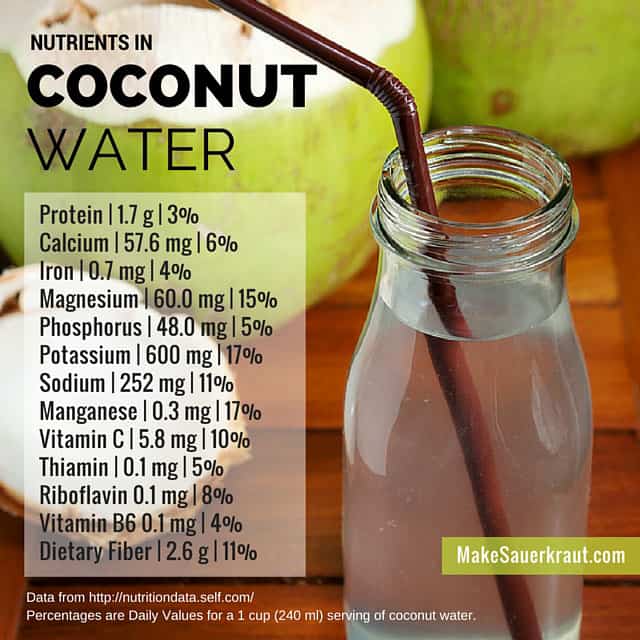
Here are some benefits you may not know about. Coconut water:
- Is high in potassium.
Potassium is critical for the proper functioning of your body’s brain and nervous system and for maintaining muscle strength. One cup of coconut water contains 600 mg of potassium similar to one cup of mashed banana at 806 mg. - A great source of magnesium.
Low magnesium levels can lead to low energy levels along with many other issues. Coconut water is one more way to increase your body’s magnesium levels. - Contains living enzymes.
The enzymes in raw coconut water aid in the digestion and metabolism of food. - Contains cytokines.
Cytokines have anti-aging and anti-carcinogenic effects on humans and supposedly slow down the normal sequence of aging. - Is rich in antioxidants.
Antioxidants absorb free radicals and toxins in our bodies. - Is an excellent alternative to sports drinks.
Coconut water is a great source of electrolytes (sodium, potassium, chloride) for amazing hydration after exercise, especially during hot weather. In addition, it can help you quit heavily processed, sugar-rich sports drinks, especially when sugar levels are reduced due to the fermentation process. - Alkalizes your system.
Drinking coconut water, with a PH level of 9.5, helps neutralize acidity in the body. - Is high in fiber, compared to other water and sodas.
One cup of coconut water contains 3 grams of fiber to help maintain blood sugar levels. This in turn prevents food cravings, sugar spikes, and sugar crashes. - Has been used as a blood plasma substitute.
Coconut water was used in World War II for emergency transfusions when blood plasma was low. Though this sounds great, it may be a myth. But coconut water has served as an emergency short-term intravenous hydration fluid. - Supports your immune system.
Coconut water contains lauric acid that is antibacterial, antifungal, and anti-viral to boost your immune system and fight infections. The fermentation process introduces additional immune-enhancing bacteria. - Aids in digestion.
Not only does the fiber content of coconut water help your digestive system, but probiotics created during the fermentation process help restore a healthy balance of bacteria in your gut. - Helps alleviate hangover symptoms.
Drinking alcohol depletes our potassium and dehydrates us. The high levels of potassium in coconut water, along with its hydrating properties, help both of these symptoms. - THAT IS FERMENTED, contains probiotics to help with digestion.
Fermenting coconut water introduces cultures of microbes into the water that create a wide range of probiotics to improve your health in numerous ways. - THAT IS FERMENTED, contains a “greater” concentration of vitamins and minerals.
Through the fermentation process, vitamins and minerals in the coconut water are made easier for your body to absorb and use, or “bioavailable.” So though that 1 cup of coconut water contains 60 mg of magnesium, your body may actually absorb far more than that, thanks to the fermentation process. - THAT IS FERMENTED, and has reduced sugar levels.
When coconut water is fermenting, the bacteria in the culture (milk or water kefir grains), consume the simple sugars in the coconut water and reduce its sugar content.
Purchasing or Making Your Own Coconut Water
Which brand to buy?
I thought I had it all figured out. However, as I put this post together, I learned that coconut waters are not all created equal.
The popularity of coconut water has resulted in companies flooding the market with varying qualities of coconut water in order to participate in the money grab. Not all companies are ethical and many resort to cost-cutting measures to increase their profits.
Big companies, such as Pepsico and Coca-Cola have their own versions of coconut water – O.N.E., Zico, Naked – with added sweeteners, concentrated syrups, and additives that don’t make the coconut water much different than consuming soda. Buyer beware.
In general, you want to look for coconut water that is the least processed and still has most of its nutrients intact.
What to Keep in Mind When Purchasing Coconut Water
Here is what I learned and what I will now look for when buying my coconut water. Make sure the coconut water you purchase:
- Is from fresh juice instead of concentrate.
To make a concentrate, coconut water is heated and cooked down into a syrup, destroying any nutrients and beneficial enzymes in the process resulting in a product that is not much better than high-fructose corn syrup. - Is from young green coconuts from Thailand.
Coconut water from older, mature coconuts (brown coconuts) is lacking in nutrients and is less flavorful. - Has no artificial preservatives, added flavorings, added sweeteners, or nasty chemicals.
- Is not high-heat pasteurized.
Coconut water that is pasteurized, or cooked at a very high temperature, has had many of its vitamins, minerals, and phytonutrients destroyed along with its enzymes denatured.
High-pressure processing (HPP) is what some companies use instead to preserve the coconut water, leaving nutrients and enzymes intact, yet killing off harmful bacteria and extending shelf life. More on this below. - Is as fresh as possible.
Plastic bottles tend to contain the freshest coconut water, then cans, and lastly tetra-paks. - Is organic.
Many companies dip coconuts in formaldehyde to preserve them for shipping to the U.S. for processing, a process not allowed under an organic label. - Is, ideally, bottled at the source.
Bottling and processing coconut water at the source results in fresh juice with nutrients intact.
A trip to my beloved Community Farm Store yielded a set of coconut waters to taste and ferment.
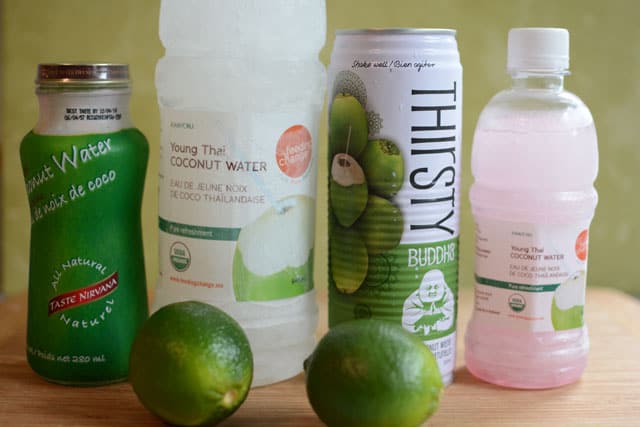
For more on the coconut water industry and what to look for when purchasing coconut water see this article from Food Babe:
How to Buy the Healthiest Coconut Water and Avoid the Worst.
Pink Coconut Water?
Fresh coconut water is clear when first removed from the coconut. However, some coconut water turns pink with time due to varying levels of antioxidants, or phenols, interacting with light. Pink coconut water is just as delicious and safe to drink. The variations are a part of nature.
I’ve sorted your choices for coconut water into three categories: Good, Better, and Best.
GOOD Coconut Waters
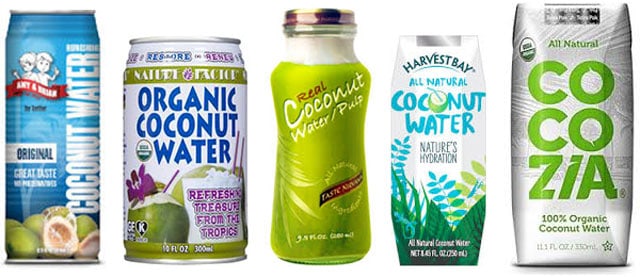
Coconut waters in the GOOD category are:
- Flash pasteurized or steam sterilized to make them shelf-stable.
Unfortunately, these heat processes do destroy some, if not all, of the nutrients and enzymes. - Not from concentrate.
- Organic.
Flash pasteurization heats the coconut water and kills bugs, but in the process, destroys vitamins and phytonutrients. From the Vita Coco website:
“We use a form of pasteurization called flash pasteurization. After the coconuts are harvested, washed, and cracked open, the liquid from inside is flash-pasteurized and then packaged in a Tetra Pak. Flash pasteurization helps maintain the best natural flavor and nutrients, eliminates potentially harmful bacteria, and makes Vita Coco shelf stable for up to 12 months.”
Steam sterilization is a combination of heat and pressure, to eliminate bacteria within coconut water and extend its shelf-life.
Look on store shelves in natural food stores and in most grocery stores for these or similar brands, which are all organic:
BETTER Coconut Waters
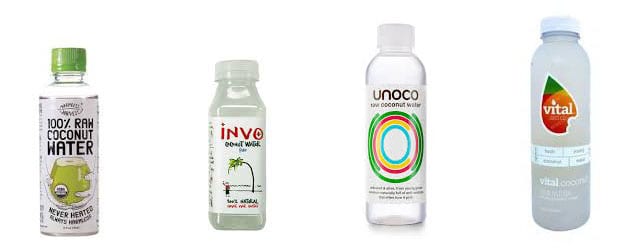
Coconut waters in the BETTER category are:
- Processed with High-Pressure Processing (HPP) to have their shelf life prolonged, even though they may say “raw” on the label.
- Not from concentrate.
- Organic.
These coconut waters are made from fresh coconuts processed with High-Pressure Processing as explained by Harmless Harvest (Their “Coconut to Bottle” story is an interesting quick read):
“High-Pressure Processing, or HPP, is an FDA-approved technique that has been used for decades with various products. This technique utilizes heatless isostatic pressure to inhibit the growth of natural microflora, such as probiotic lactobacilli, and kill aerobic pathogens. Bottled products are placed in a water bath and submitted to tens of thousands of pounds of pressure, dispersed evenly throughout the cells of the cold water and products. Through this process, raw products gain shelf life while retaining their flavor and aroma.”
“Bottled products are placed in a water bath and submitted to tens of thousands of pounds pressure, dispersed evenly throughout the cells of the cold water and products. Through this process, raw products gain shelf life while retaining their flavor and aroma.”
Look in the refrigerator section of a natural foods store for these or similar brands.
- Harmless Harvest, bottled in Thailand.
- Invo, sustainable farming; bottled in Thailand.
- Unoco, the juice is frozen and then shipped to the U.K. for HPP processing.
- Vital Juice.
BEST Coconut Waters
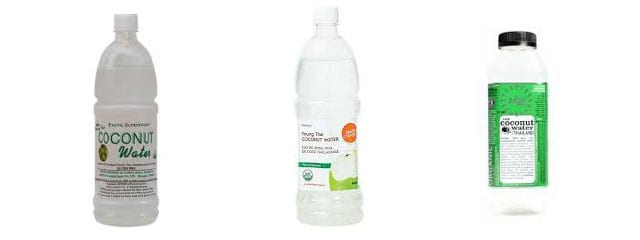
Coconut waters in the BEST category are:
- Raw.
These coconut waters have not been heated and are as close as you can get to drinking water straight out of the coconut. - Not from concentrate.
- Organic.
Organic, raw coconut water is your best bet, if available in your area. Be ready to pay a pretty penny for raw coconut water.
These brands of coconut water are as close as you can get to the real stuff. Most brands use young coconuts from Thailand, process them at the farm, freeze it immediately, and then ship it frozen. From the Feeding Change website:
“Every care is taken to preserve all the essential nutrients, enzymes, and electrolyte-loaded goodness. Within just a few hours of harvesting, FeedingChange Young Thai Coconut Water is fresh-frozen in our production facility just 15 minutes from the farm. And it stays frozen—throughout its journey, to the freezer aisle in leading organic grocery and premium health food retailers—until you are ready to drink all its delicious goodness.”
Look in the freezer section of a natural foods store for these or similar brands. You should see the words “raw,” “unpasteurized” and “no added sweeteners” on the label.
My current coconut water of choice, Blue Monkey, is from young, green coconuts grown in the Philippines, Thailand, and Indonesia. They are not organically grown, though “sustainably sourced” according to the company website.
I may switch to an organic one at the GOOD level, or try Feeding Change from the BEST level if I really want raw coconut water, and drink less to offset the higher cost.
Coconut Water
Making Your Own Coconut Water from Green Coconuts
If you want to be adventurous and have access to reasonably priced young green coconuts, you can “make” your own coconut water.
Green coconuts are readily available in Asian, Latino, and other ethnic markets. Look for the young, green shell or, if the outer shell has been removed, a white husk with little or no blemishes.
“Bottled coconut water cannot compare to fresh coconut water. Of course, bottled is far more convenient and doesn’t require tools, but if you’re at home and you have a few basic tools, you’ll enjoy amazingly fresh coconut water AND coconut milk AND coconut meat for what you would have paid for just the coconut water. You’ll also get to smash the heck outta stuff. Plus, it’s a good workout. And what if you’re ever stranded on a beach somewhere with only fallen coconuts to eat? Knowing how to crack open coconuts could be considered a survival skill. – The Cultured Cook“
See more at:
The Cultured Cook: DIY Coconut Water
Body Ecology: Young Green Coconut Kefir
Cultures for Making Fermented Coconut Water
To ferment coconut water you have to add a culture to coconut water. I go over the pros and cons of four options:
- Milk Kefir Grains
- Water Kefir Grains
- Yogurt Whey
- Powdered Starter
If you have allergies to dairy, you’ll want to use water kefir grains.
Milk Kefir Grains
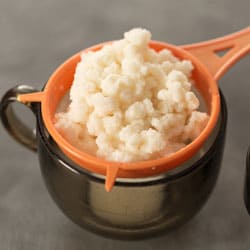
Milk kefir grains are not truly a grain but a grain-like mass of bacterial and fungal cells that grow together into a white clump resembling little cauliflower florets and are most often used to make Kefir, a fermented milk product. Their food of choice is lactose, which is why they are commonly used to make milk kefir.
I always make my fermented coconut water with milk kefir grains, as I learned from Jessica Prentice in her book
- Used Book in Good Condition
- Jessica Prentice (Author)
- English (Publication Language)
I like them because they ferment quickly and consistently, do not grow as rapidly in the coconut water as they would in milk, therefore one less “pet” to care for, and do not require periodic feeding with minerals as the water kefir grains seem to require.
Since coconut water is a nice balance of sugars and nutrients, it is able to “feed” the grains, and keep them viable, during the fermentation process.
You purchase milk kefir grains once, and if regularly used, they will last a lifetime.
Milk kefir grains contain more strains of beneficial bacteria than water kefir grains. I don’t know whether the bacteria strains continue to multiply in coconut water, but I would think so since they continue to thrive and slowly grow. I have been fermenting coconut water with the same grains for over seven years.
See below for sources.
Water Kefir Grains
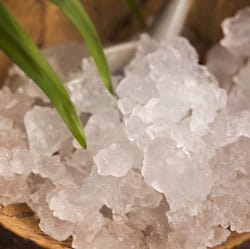
Water kefir grains are small, translucent, gelatinous structures comprised of assorted bacteria and yeasts. They look like beautiful jewels. They will last forever and multiply with proper care. They contain fewer strains of beneficial bacteria than milk kefir grains.
If you are lactose intolerant, these are a great option and beverages fermented with them are a great way to establish a stronger and broader range of bacteria in your gut to eventually make you able to digest dairy.
The food of choice for water kefir grains is sugar which is why you see them recommended for making sodas, and… coconut water. They are not super hardy, and I find them picky about where they live and what they like to eat. Most water kefir soda recipes emphasize the need to periodically feed them minerals (egg shells) and use mineral-rich sugar (Sucanat and Rapadura).
Most recipes on the internet for fermented coconut water have you use water kefir grains.
See below for sources.
Yogurt Whey
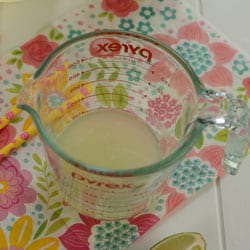
Yogurt whey is the clear liquid you see floating on top of yogurt. Whey is full of beneficial bacteria that can be used to culture not only yogurt but also a variety of refreshing drinks.
Grab yourself a quart of full-fat, natural yogurt, and some coconut water and you have all the makings for fermented coconut water, and… yogurt cream cheese. See below.
Wellness Mama has a short post describing how to make liquid whey:
How to Make Whey and Cream Cheese
She has you tie the bag of dripping yogurt to a cabinet handle. I added a small hook to the underside of one of my kitchen cabinets for hanging my dripping yogurt. A tad bit easier.
Use the cream cheese to make a delicious soft cheese spread, a favorite in our house. Just add crushed garlic and one teaspoon of salt to the cream cheese and you’re set.
If you have more whey than you need for fermenting your coconut water, you can successfully freeze it in small containers. Thaw before use.
Powdered Starter
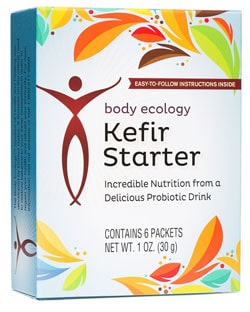
A powdered starter may seem less intimidating than kefir grains. The quality of them depends upon what bacteria and how broad of the range are in the culture. You have to periodically repurchase powdered starter since one package can only be used for 5-7 fermentation batches.
Here’s a review from the Body Ecology website that makes me want to try again:
“I just started using this product about 3 weeks ago to make coconut kefir. I made the first batch with raw coconut water I found at Publix but did not have good results with this. I then purchased the coconut water available thru the body ecology website and am loving it! The first batch took a lot longer to ferment than the time recommended in the directions but the next batch I used 1/2 cup of the first batch as a starter and it was super fast to ferment.
I am combining this with other fermented foods but am getting much better results since adding coconut kefir. I have longstanding “gut problems” and am thankful for the relief I am finally getting. Thank you for making this starter available and also the great info available on your website! (Posted on 2/6/2016)”
For the first batch, the fermentation process might be slower. You can use a portion of your fermented coconut water as a starter for a few subsequent batches until it loses its potency and then you’ll need to use a new packet of starter.
Three starters to choose from:
Body Ecology Kefir Starter
I like the wide range of bacteria in this starter from Body Ecology. It was on their website that I first learned about fermenting coconut water. I believe they have spent a lot of time perfecting the strains of bacteria used in their starter. From the Body Ecology website:
“Contains 6 packets which can be used an average of 7 times each. 6 tablespoons of the previous batch will ferment 1 quart of liquid.”
Body Ecology Kefir Starter Ingredients:
- Lactococcus lactis
- Lactococcus cremoris
- Lactococcus diacetylactis
- Leuconostoc cremoris
- Lactobacillus plantarum
- Lactobacillus casei
- Saccharomyces boulardii
- Inulin
You’ll notice inulin on the list. Inulin is a prebiotic that kick-starts the fermentation process and is now being promoted for healthy digestion. It is found in raw onions, raw garlic, raw leeks, asparagus, and bananas to name a few. There’s a blog post in the pipeline for how to use prebiotics in fermentation and tips for including them in your diet.
Cultures for Health Kefir Starter Culture
The ingredients label for the starter culture from Cultures for Health states, a proprietary blend of selected strains of:
- lactococci
- lactobacilli
- Leuconostoc
- Saccharomyces fragilis
Make sure you order the Starter Culture and not the Kefir grains.
Cultures for Health Starter Culture
Yogourmet Kefir Starter
This is the culture starter I first tried years ago when fermenting coconut water.
Ingredients, active bacterial culture:
- L. lactis
- L. cremoris
- L. diacetylactis
- L. acidophilus
- Lactic yeasts
- Skim milk powder
I don’t like the inclusion of skim milk powder. I’m retesting a batch now; it took longer than usual but fermented into a lovely, effervescent drink.
Sources for Milk and Water Kefir Grains
To ferment your own coconut water with kefir grains, you first need to obtain the grains, either milk kefir grains or water kefir grains. This will be your biggest hurdle. Once you have the grains, the rest is easy-peasy.
Your best bet is to find a kefir-making friend. When fermenting in milk or sugar water, the grains multiply and after awhile anyone who is making milk kefir or kefir sodas will have grains to spare.
I harvested the grains I’m using for fermenting coconut water – from the growth of the grains in my milk kefir – over seven years ago. They are still working hard for me, turning a half-gallon of coconut water into an effervescent, slightly sweet but good-for-me drink on a weekly basis.
I would not recommend dehydrated milk kefir grains due to the number of people that have not had success with them. Here’s why The Kefir Lady has stopped selling dried kefir grains:
“All three of our cultures come fresh now (milk kefir grains, water grains and kombucha cultures). We have discontinued selling dried water grains. The trouble with dried water grains is the same as with dried milk kefir grains, they can lose their growth factor. They still work, but may not grow.
I have discontinued selling any dried cultures. they take time to wake up; a whole month for kombucha, and possibly several weeks for milk kefir grains. Just as everyone else’s dried milk kefir grains, mine are also of inferior quality. The drying process damages their growth factor and it takes weeks to get a good tasting batch.”
Most sellers provide 1 tablespoon of grains. Online prices will range from $12-$35, so it is worth your while to connect with someone locally through the first three options below.
- Local Health Food Stores.
Visit your local health food store and speak with them there.
Often, the staff is either culturing their own kefir and will have grains to share or can put you in contact with someone who has kefir grains. - Local Online Buy and Sell Organizations.
Many individuals who make their own kefir have grains to spare and advertise on Craigslist, Kijiji and other online directories, selling their grains for $0-$10.
You usually will have to bring your own container. Enter “milk kefir grains” or “water kefir grains” in the search bar. - Local Chapters of the Weston A. Price Foundation.
This is a non-profit educational organization dedicated to restoring nutrient-dense foods to the human diet. There are hundreds of chapters worldwide that give various workshops and lectures and can connect you with local sources for kefir grains.
Find a local chapter through one of the links below and contact the leader:
Chapters of the Weston A. Price Located in the United States
International Chapters of the Weston A. Price Foundation - Amazon, Milk Kefir Grains.
Yes, there are sellers for kefir grains on Amazon. Who knew?
I read through all the reviews and found this seller for milk kefir grains to be the best though I have never bought grains from them. Purchase includes a 29-page eBook that covers all the basics for making milk kefir. - Amazon, .
I have not purchased from this company but it does receive positive reviews. - Kefir Lady.
I bought my first Kombucha SCOBY – heart-shaped! – from this gal almost 15 years ago and its decedents are still making Kombucha for me, and all my friends. She deals only in cash or Amazon gift cards. - Kombucha Kamp. International shipping.
- Organic Cultures: Milk Kefir Grains. International shipping.
- Organic Cultures: Water Kefir Grains. International shipping.
- Yemoos Nourishing Cultures. A family-run operation that has you send an adoption fee after receiving your cultures.
A Look at Some Fermenting Coconut Water
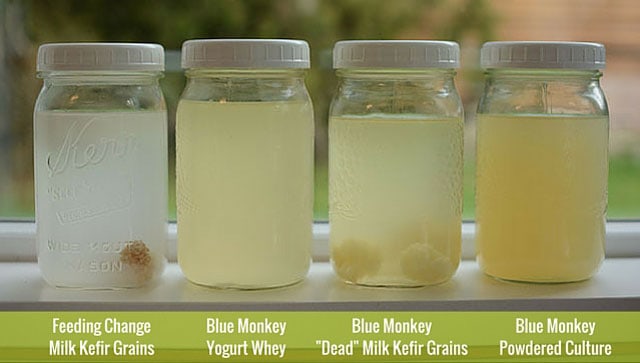
I include the photo above to show the variance of color for coconut waters and the impact of starter on the color. So before I start on the recipe, here’s what’s in them:
- For the first jar, I used raw coconut water – Feeding Change – and some of my seven-year-old milk kefir grains, hence the brownish hue to the grains. Notice how clear the water is. Before fermentation, it tasted flat without much sweetness. It fermented in 18 hours.
- For the second jar, I used a pasteurized coconut water – Blue Monkey – and yogurt whey for the culture. Before fermentation, it tasted the sweetest of the brands I tried and had a strong coconut flavor. It took 4 days to ferment and had just a slight tang to it.
- For the third jar, I used Blue Monkey and added in some rinsed “dead” milk kefir grains that have been sitting in my refrigerator for at least a year, totally neglected. Stay tuned. I’ll let you know if they ever start working again.
- For the last jar, I used Blue Monkey (I do have a case of it in my garage!) and Yogourmet powdered culture (probably 3 years old) that I’m able to purchase here in Canada. Within 24 hours, the powder had settled to the bottom of the jar and I saw little or no signs of fermentation. By day 4 it had fermented quite nicely. A pleasant flavor and a nice amount of fizz.
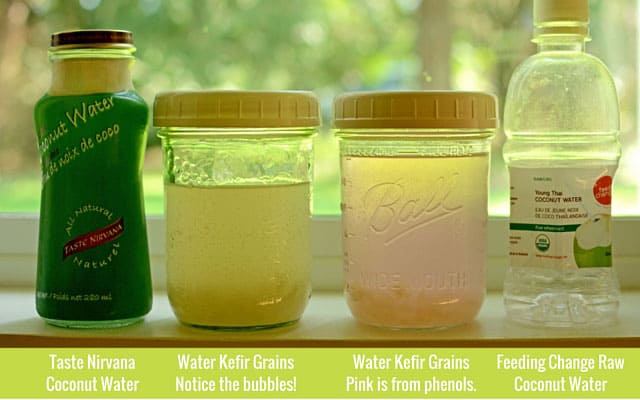
Here are two more jars of fermenting coconut water:
- For the first jar, I used Taste Nirvana coconut water and some water kefir grains. I did a small batch to match the size bottle purchased. I used just one heaping tablespoon of water kefir grains. Notice the bubbles – 24 hours after starting – indicating fermentation is happening.
- For the second jar, I used raw coconut water – Feeding Change – and water kefir grains, again. I started it a day later than the other jar, so no signs of fermentation, yet. The pink color is normal and is from naturally occurring antioxidants. I found its flavor to be the most complex with a depth of flavor some of the other coconut waters lacked.
Recipe for Fermented Coconut Water
I share fours ways to make fermented coconut water, that differ just by the culture you use. Choose the culture that you find easiest to obtain and see how it works for you.
Here I used raw coconut water and milk kefir grains that have turned brown over the years I’ve used them for fermenting coconut water.
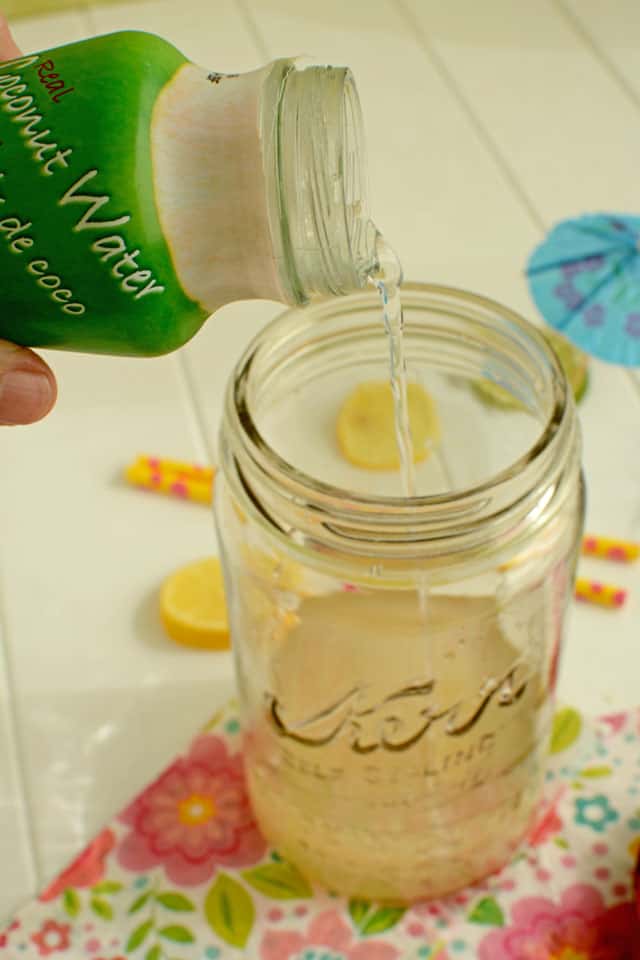
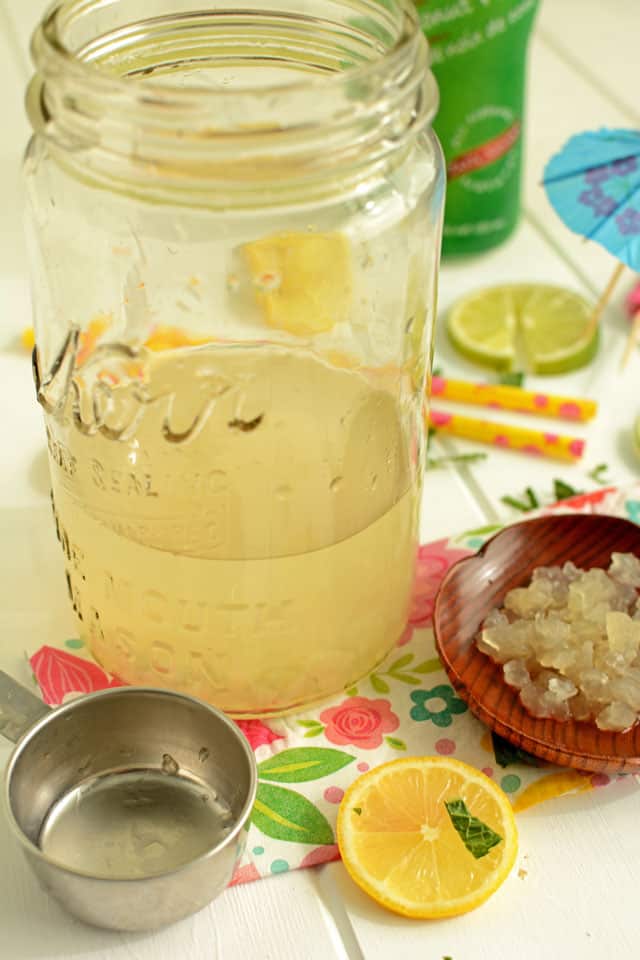
This is a small batch of coconut water fermented with water kefir grains and a 9.5 oz (280 ml) jar of Taste Nirvana coconut water. For this sized batch, I use just 1 rounded tablespoon of water kefir grains. The Taste Nirvana water is much more yellow than the raw Feeding Changing coconut water in the first picture.
Be sure to read the Helpful Notes and Tips at the end of the recipe before popping open your coconut water.
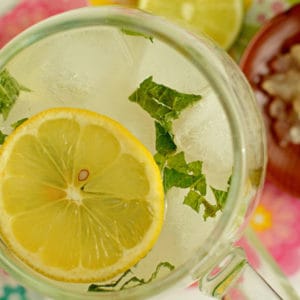
Fermented Coconut Water
INGREDIENTS
- Quart (liter) canning glass jar and lid
- 1 quart (liter bottle or 2-520 ml cans), approximately, of coconut water
- Culture or choice, (milk kefir grains, water kefir grains, yogurt whey or powdered starter culture)
- Optional strainer
INSTRUCTIONS
- In a quart (liter) canning glass jar, or something similar, pour in coconut water to within 2 inches from the top. Do not overfill. You need to allow room for the gasses that build up during the fermentation process.
- Add culture of your choosing:¼ cup milk kefir grains,¼ cup water kefir grains,½ cup yogurt whey, orpacket powdered starter (Follow directions on package.)
- Snugly put on the lid and leave coconut water to ferment on your counter. Ambient room temperature of 68-72°F (20-22°C) degrees is ideal.If using yogurt whey or powder starter, mix the contents a few times each day. Just turn the jar upside down and that back upright. This keeps the culture distributed throughout the coconut water and prevents mold from developing on the surface.
- Check after 12-18 hours.Look for tiny bubbles rising to the surface. You may see the grains moving around in the bottle.Take the lid off, keeping your face away from the opening until the gasses have escaped.Taste. There should be less sweetness and some fizz.
- If it has soured to your liking – I prefer a bit of sweetness to mine – it’s ready. If it is still too sweet, put the lid back on and check again in 6-10 hours.
- When done, place in your refrigerator and enjoyIf using water kefir grains, strain into a new container keeping ¼ cup of the grains for the next batch. If you use too many grains fermenting can progress too rapidly, and you can end up with alcohol.
Notes and Tips
- Make sure to leave some head space in your jar of fermenting coconut water. As the bacteria in your culture eat the sugars in the coconut water, gasses are created. These gasses have to go somewhere, hence the pocket of air at the top of your jar.
- How tight to put the lid on? There is a fine line between tight enough to trap most of the gasses so your drink has some fizz to it and not so tight that you have a dangerous buildup of gasses that could cause your jar to explode. Error on the side of not too tight, check it within 18 hours and don’t ferment longer than 48 hours.
- To strain or not to strain? When using milk kefir grains, I do not strain them, but instead place the jar I fermented in directly into the refrigerator, grains and all. The coolness of the refrigerator slows down fermentation and the grains live off the residual sugar in the coconut water. This is why I stop fermentation when there is still some sweetness in the water. You can also pour your fermented coconut water through a strainer and store your kefir grains in a small jar of sugar water kept in the refrigerator. This is an extra step I don’t care to take, but you may prefer to do so.
- Three variables to look at as your adjust your fermentation: Sweetness of the coconut water. The sweeter the coconut water the faster fermentation will proceed. The more sugar you feed the bacteria the faster they will work for you. Taste amount of sweetness in coconut water before ferment, so you understand this variable. Ambient Temperature. The warmer the area in which you’re fermenting, the faster fermentation will proceed. In summer, my coconut water ferments in 12 hours, whereas in winter it may take 24 hours. Fermentation Length. The longer you ferment your coconut water the less sweetness there will be. I like a tad of sweetness to my finished ferment, so I ferment for a shorter period of time.
- Home too cool? If your home is too cool and it is taking longer than 48 hours for your coconut water to ferment, your can either wrap the jar in a blanket or set it on a heating pad (monitor carefully) to give the bacteria a little more heat to do their work. Ideal fermentation temperature is 68-72°F (20-22°C).
- Want to make a larger batch? The recipe I give is for 1 quart, but I usually make one-half gallon which lasts a week in my household. I use closer to 1/2 cup of water kefir grains and 3 cans of 520 ml coconut water which fits nicely in the tall half-gallon canning jars.
- To wash or not to wash your fermentation jar between batches? I don’t wash my fermentation jar with every batch. The bacteria in the culture are creating a perfect environment for the fermentation process and the less I mess with it the better, I feel. So, I only wash the jar every 5 or 6 batches when the jar gets too dirty or when there is a build-up of residue on the bottom of the jar.
- White gunk building up on the bottom of your jar? This is just sediment from the coconut water and nothing to worry about.
- Coconut water not fermenting? Try a different brand of coconut water, perhaps a raw coconut water. Pasteurized coconut water does not always ferment easily and maybe the brand you’re using is pasteurized by high heat for a longer time than the flash-pasteurized brands. Make sure you are fermenting at a warm enough temperature (68-72°F, 20-22°C). Play around with your ratio of grains to water. The greater the proportion of grains the faster the coconut water will ferment. Keep an ear tuned for the sound of gas escaping your jar, which indicates fermentation is happening.
- Coconut water turning to alcohol? Reduce the amount of grains and/or the length of time you’re fermenting. Water kefir grains grow so rapidly that you’ll have to regularly reduce the amount. You won’t have this issue with milk kefir grains which grow much more slowly.
- If the fermentation process has not started within 48 hours, toss the coconut water, troubleshoot and try again. Coconut water is a perishable product. Without a working culture, it is not fermenting but degrading as it sits on your counter. NOTE: If you are using yogurt whey as your culture, it can take up to 4 days. You’re fine to leave it that long as long as you detect a shift in sweetness and a bit of fizz starting within 48 hours.
- Store finished ferment in the refrigerator. And, don’t leave a sealed bottle out of the refrigerator for too long. Fermented coconut water is alive and will continue to ferment, eating the sugars and creating a buildup of gasses that have to go somewhere. This happens very slowly in your refrigerator and rather fast in a hot car. Though I keep a bottle in my car on a driving trip, I’m opening it throughout the day, which allows the gasses to whoosh out.
12 Ways to Enjoy Fermented Coconut Water
I always drink my fermented coconut water au natural, but coming across these recipes using coconut water has my taste buds watering for something more. Here I share what I found while scouring the internet for coconut water recipes.
And, don’t forget how including this powerful fermented food in your diet can help with your digestion. From Body Ecology:
“A half-cup of the coconut water kefir with meals greatly helps digestion. You can add ginger, stevia, lemon, and/or lime if desired. A half-cup at bedtime will help establish a healthy inner ecosystem. Studies from Europe show that when you are lying still during sleep, the microflora reproduces faster. In the morning, combine a half cup of the young coconut water with unsweetened cranberry or black currant juice, as a great wake-up tonic.”
Plain Iced Fermented Coconut Water
What could be simpler than pouring some fermented coconut water over a tall glass of ice? You can add ginger, mint, basil, lemongrass, lemon or lime slices for flavoring if desired.
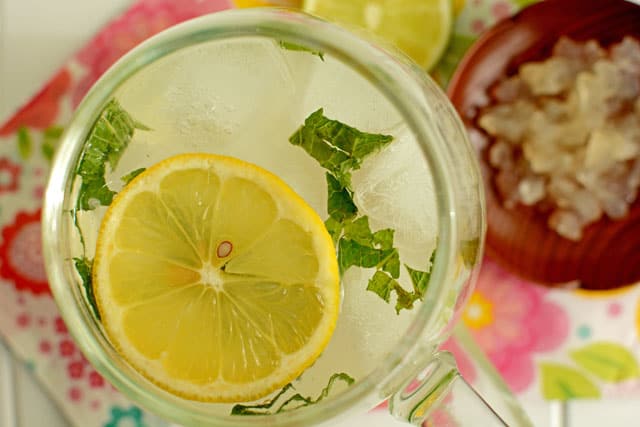
DIY Electrolyte Drink
Here’s what Renee over at Raising Generation Nourished says about her DIY Electrolyte Drink:
“A few years back when my first daughter got her first cold I did a quick freak out at the ingredient list in the Pedialyte isle and decided I would just make my own.”
“A mixture of cleansing lemon and energy-giving raw honey was welcomed by my little one at the time. And the sea salt packed a mineral punch that kept her electrolytes in balance while she fought off her first cold.”
In her recipe, be sure to substitute fermented coconut water for the plain water.
Cinnamon Coconut Kefir Water
From Michelle Toole at Healthy Holistic Living shares this about coconut water kefir in her Cinnamon Coconut Kefir Water recipe:
“What’s more important and why it’s considered better than regular kefir is the fact it doesn’t contain the problematic substances that regular dairy has such as casein and lactose. This just means that your body will process these probiotic benefits better. Coconut water kefir is believed to be the most beneficial probiotic beverage because it has a much more potent effect on the digestive system than any dairy probiotic food such as yogurt.”
Fermented Coconut Water Lemonade
From Bee Yin Low at Rasa Malaysia:
“I came from a tropical island in Penang, Malaysia, a picturesque and beautiful island fringed with a shimmering blue sea and swaying coconut trees. I grew up drinking fresh and refreshing coconut water, from plump and just-fallen-off-the-tree coconuts. Coconut water is our thirst-quencher to beat the tropical heat.”
Wellness Shot – Turmeric Tonic with Coconut Water, Ginger, and Honey
Turmeric is fast becoming a popular supplement and superfood which is why I included both powdered and fresh turmeric – and refreshing pineapple – in one of the recipes in my SureFire Sauerkraut Recipe Collection eBook. I was happy to come across this coconut water recipe that also uses turmeric. Just substitute fermented coconut water to boost the power of this wellness shot.
From Heather at Mommypotamus:
“This turmeric version is my “go-to” when I need a natural energy boost. It has an earthy flavor with a ginger zing, and it’s infused with compounds that many believe support gentle detoxification. One particular component of turmeric – curcumin – has been studied for its ability to prevent premature aging, reduce depression, manage arthritis and blood sugar, and act as a painkiller, among other things. (source 1, source 2) I haven’t found any studies regarding its effect on energy levels, but my experience is that it seems to help with alertness. Curcumin is a powerhouse with so many documented benefits – it’s been referenced in PubMed over 6,000 times!”
Turmeric Tonic with Coconut Water, Ginger, and Honey
Coconut Mojito
Use this other recipe from Rasa Malaysia to add some tropical flavor to your day:
Fermented Coconut Water + Mint leaves + Lime Juice + Rum + Ice = Mojito. Watch below.
More on the Coconut Mojito blog post.
Gin & (Fermented) Coconut Water
Now that we have local, organic gin – Ampersand Gin – where I live, I thought this recipe by the NY Times would prove the perfect match:
Post-Workout Chocolate Coconut Kefir Smoothie
Danielle at Fermented Food Lab goes decadent with her Post-Workout Chocolate Coconut Kefir Smoothie:
“This recipe reminds me of the chocolate banana ice cream I make in the summer with frozen bananas, raw cacao and cacao nibs, except it is jam-packed with magnesium, potassium, probiotics and other minerals and vitamins the body needs after a workout. This smoothie will not only help you recover quickly, but it is also very satisfying. The creamy texture and richness of the chocolate make it taste like a dessert.”
Post-Workout Chocolate Coconut Kefir Smoothie.
Strawberry Coconut Water Smoothie
Jennifer at Peanut Butter and Peppers has this to say about her Strawberry Coconut Water Smoothie:
“One thing this smoothie is great for is a hangover. I am telling you this from experience. If I drink coconut water before I go to bed or as soon as I get up, no hangover, at all! Not a headache, sick or anything! I love it!”
Strawberry Coconut Water Smoothie
Morning Strawberry Piña Colada Smoothie
Trinidadian-born writer Patrice Grell Yursik at Afrobella, who shares her Morning Strawberry Piña Colada Smoothie with the link below, has this to say about coconut water:
“In Trinidad, I discovered, coconut water is pretty much consumed as is, or it’s used as a mixer in cocktails. I never thought of blending it with ingredients like strawberries and spinach until this year. And now I ADORE a coconut water-based smoothie. It rejuvenates you after a workout, delivers the antioxidants, calcium, magnesium and potassium your body needs, and the sweet, light, pleasant flavor doesn’t overpower the smoothie as yogurt or juice can. When I push myself to exercise and then drink one of these in the morning, I feel like nothing can stop me!”
Coconut Water Smoothies: The New Breakfast of Champions
Coconut Kefir Piña Colada Smoothie
Ester Perez at Nurture My Gut has this to say about her Coconut Kefir Piña Colada Smoothie:
“This Coconut Kefir Piña Colada Smoothie is sooooo good that you won’t even know it is full of good bugs! An army ready to do good work in your gut! Put those soldiers to work people! We need them!”
Coconut Kefir Piña Colada Smoothie
Green Kefir Smoothie
And last but not least, Katherine at Green Thickens recommends fermented coconut water to strengthen your digestion with her Green Kefir Smoothie:
“I love the energy a green shake gives me. I like having them at that 3-4 pm slump. I always feel clean and revitalized after one. Adding water or coconut water kefir to my green smoothie not only increases the absorbability of the nutrients in the smoothies but also helps to heal and strengthen the digestive system and immune system.”
BONUS TIP for Car Travelers: Fermenting on the Road
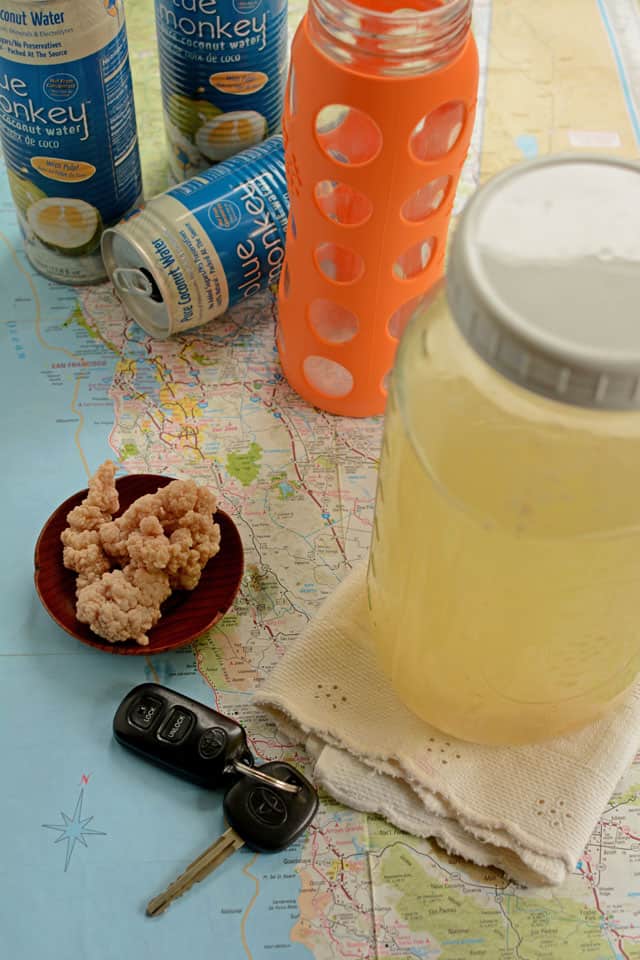
Fermented coconut water is the perfect ferment to travel with. Unlike Kombucha, making more on the road is as easy as opening a few cans of water.
I learned the hard way how important fermented foods were for keeping my digestion healthy and regular. We do a road trip down to California every summer to visit family and do our south-of-the-border shopping.
During the first few trips away from my home and its arsenal of gut-supporting foods, digestion started to slow down, way down. It made me realize just how important my daily consumption of fermented foods was. Now, I do not leave home without my sauerkraut and fermented coconut water.
I use one of those tall half-gallon canning jars, 1/2 cup milk kefir grains and 3-520 ml cans of coconut water. A different setup might work better for you.
Before leaving I ferment a batch, which is kept in my cooler until there’s about 1/2 cup of fermented coconut water left in the bottom. Then, I pour 3 cans of coconut water into the jar, leave it out of the cooler in a safe place in my car to ferment. It’s done fermenting 8-12 hours later, depending upon temperatures, and is returned back to the cooler for consumption.
In the morning, I fill my travel mug with fermented coconut water. Drinking some at each rest stop really helps keep energy levels maintained and some clear focus sustained for the long drive.
Works like a charm. Just buy whatever coconut water you can find along the way, or bring some extra with you.
Sources and More Information
9 Best Coconut Water Brands, According to Experts
Coconut Water: “Health Hype or Hell of a Sports Drink!?” & “Top 5 Healthiest Choices”
Coconut Water is as Good as Ingesting a Commercial Sports Drink…
Coconut Water: Far More than Just a Refreshing Beverage
Is Water Kefir as Beneficial as Milk Kefir?
The Many Benefits of Coconut Water Kefir
Last update on 2024-04-23 / Affiliate links / Images from Amazon Product Advertising API

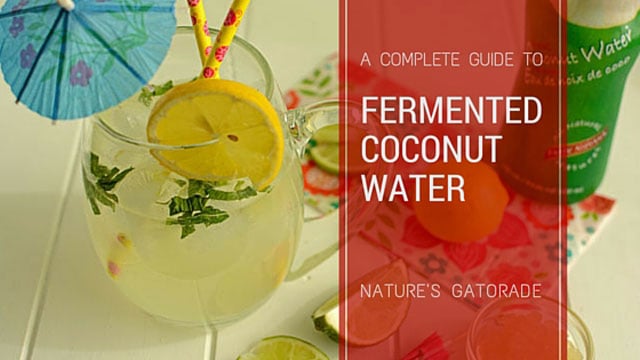

 This post may contain affiliate links which won’t change your price but will share some commission.
This post may contain affiliate links which won’t change your price but will share some commission.
